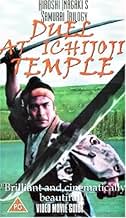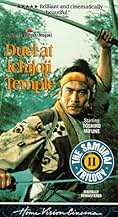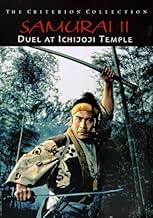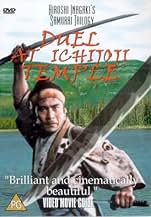IMDb रेटिंग
7.3/10
7.3 हज़ार
आपकी रेटिंग
अपनी भाषा में प्लॉट जोड़ेंMusashi Miyamoto returns to Kyoto after years of absence. After a series of fights against the Yoshioka School, he challenges its master to a duel.Musashi Miyamoto returns to Kyoto after years of absence. After a series of fights against the Yoshioka School, he challenges its master to a duel.Musashi Miyamoto returns to Kyoto after years of absence. After a series of fights against the Yoshioka School, he challenges its master to a duel.
फ़ीचर्ड समीक्षाएं
The follow-up to 1954's excellent Musashi Miyamoto, Duel at Ichijoji Temple picks up the story several years later, as an exiled orphan-turned-swordsman gains notoriety via a bloody tour of fatal duels. His reputation precedes him in returning to his hometown, where old rivals of both a violent and intimate nature await. This is a film about personal growth - specifically that of the samurai himself, who struggles to learn the key concepts of what his new life actually entails and where the rift lies between honor and reverence. We're never quite sure if Musashi takes this lesson to heart, particularly since he's so keen to maintain an impenetrable outer facade in almost every situation. It's a tricky role for period veteran Toshiro Mifune, who struggles with the more nuanced, flatter aspects of the character. In the previous episode, with the fires of young-adulthood to toy with, he excelled. Here, faced with the malaise of mid-life and the accompanying questions of his own being, his performance is far less sublime. The plot, cramped with too many faces and several seemingly-pointless subplots, does him no favors in dancing around the issues and repeating itself on more than one occasion. This could have been an excellent one-act show, and the final half-hour could still stand alone as precisely that. It lacks the gumption of its predecessor, however, and too often cuts away just as the action is getting good.
The great cast that was in Musashi Miyamoto, the first part of this samurai trilogy continues in the second part with a few additions.
By this time Musashi Miyamoto has been on the road for three years and is still learning. The most important lesson as a Samurai will not be learned until the film is almost over. Another important lesson comes quickly after that, and it will interesting to see how it plays out in the final part.
In the opening Musashi Miyamoto is doing battle with a samurai similar to our buddy Hanzo. They are the only two I have ever seen use chains.
After this he heads to Kyoto to do battle with the best in the capital, and also to get himself mixed up with the two women who are in love with him.
Love, fickleness, treachery, rape, revenge, honor, and great sword fighting all have a place in this magnificent film.
The amazing cinematography and scenery also place an important part.
This is truly a samurai classic.
By this time Musashi Miyamoto has been on the road for three years and is still learning. The most important lesson as a Samurai will not be learned until the film is almost over. Another important lesson comes quickly after that, and it will interesting to see how it plays out in the final part.
In the opening Musashi Miyamoto is doing battle with a samurai similar to our buddy Hanzo. They are the only two I have ever seen use chains.
After this he heads to Kyoto to do battle with the best in the capital, and also to get himself mixed up with the two women who are in love with him.
Love, fickleness, treachery, rape, revenge, honor, and great sword fighting all have a place in this magnificent film.
The amazing cinematography and scenery also place an important part.
This is truly a samurai classic.
I've watched the entire trilogy of the Musashi Miyamoto films, of which this film is the second part. The first film, titled simply "Musashi Miyamoto," introduces us to the characters of this and the third film. Without having seen the first film and developing some interest in the welfare of the characters, I certainly wouldn't have sat through the second and third films.
"Duel at Ichijoji Temple," this film, deals with Musashi's exploits as a sort of samurai knight-errant, seeking glory in a very ambiguous and roundabout way. Two women are trailing after him, as Kurosawa films would say, "like goldfish dung." Musashi himself is a flat character on whom Toshiro Mifune's acting skills are wasted. He displays very little emotion or intellect, despite his supposed interest in one of the women and enlightening education by his monk teacher (as we saw in the first film).
If Musashi is flat, the female characters are steamrolled. Their hand wringing, collapsing, and sobbing is typical of American movies of this time period and grows tedious in a samurai film. Having seen other films from this time period set in the days of samurai, I've seen that much more can be done with female characters. The plot was likewise predictable and slow-moving.
If you don't care about characters or plot, the high points of the movie may compensate: beautiful color landscapes and Toshiro Mifune's thrilling fight scenes. Otherwise, I recommend films by Kurosawa or Mizoguchi ("Sanjuro," the mysterious "Ugetsu") over this trilogy. 5/10
"Duel at Ichijoji Temple," this film, deals with Musashi's exploits as a sort of samurai knight-errant, seeking glory in a very ambiguous and roundabout way. Two women are trailing after him, as Kurosawa films would say, "like goldfish dung." Musashi himself is a flat character on whom Toshiro Mifune's acting skills are wasted. He displays very little emotion or intellect, despite his supposed interest in one of the women and enlightening education by his monk teacher (as we saw in the first film).
If Musashi is flat, the female characters are steamrolled. Their hand wringing, collapsing, and sobbing is typical of American movies of this time period and grows tedious in a samurai film. Having seen other films from this time period set in the days of samurai, I've seen that much more can be done with female characters. The plot was likewise predictable and slow-moving.
If you don't care about characters or plot, the high points of the movie may compensate: beautiful color landscapes and Toshiro Mifune's thrilling fight scenes. Otherwise, I recommend films by Kurosawa or Mizoguchi ("Sanjuro," the mysterious "Ugetsu") over this trilogy. 5/10
Samurai II: Duel at Ichijoji Temple is the second part of the so-called Samurai trilogy by Inagaki Hiroshi about legendary historical figure Miyamoto Musashi who was a highly accomplished samurai who wasn't only a great fighter but also an intellectual philosopher and a skilled artist. This movie shows how a young ronin travels the country for enlightenment and training for several years to become an accomplished samurai.
The main plot of the movie focuses on Miyamoto Musashi challenging a martial arts school. He also meets respectable opponent Sasaki Kojiro who he will eventually fight in the last film. His relationship with Otsu is further explored as she patiently waits for his destiny to be fulfilled.
In comparison to the first movie, this sequel has more fight scenes that are quite dynamic, epic and tense. The movie starts with an impressive duel and ends with a fight between Miyamoto Musashi on one side and eighty martial arts school students on the other side. The film has an overall quicker pace than the first part and is thoroughly entertaining.
All beloved characters from the first movie are back in the sequel and Mifune Toshiro's acting skills are once again quite impressive even though he seems to be acting too impulsively at times to portray a character who has undergone changes to find peace of mind. Mifune Toshiro fits the role much better in the energetic first film and accomplished third movie of the trilogy.
The main reason why this movie is the weakest part of the trilogy is because it skips three years in the life of Miyamoto Musashi and fails to tell how the protagonist has changed. This is even more inappropriate regarding the side characters. The last time we saw the protagonist's childhood friend Matahachi, he was engaged to Otsu but had parted with beautiful Akemi and her manipulative mother Oko to protect them against bandits. Three years later, he has suddenly married Oko who is though having a romantic relationship with Toji who works for a wealthy martial arts school owner whom he expects to marry Akemi and hopes to make lots of money in the process. It's never explained how Oko and Matahachi got married, how their relationship failed and how Toji met the unstable trio.
Despite a few plot holes and some lack of character development, it's essential to watch Samurai II: Duel at Ichijoji Temple as a link between the energetic first film and the accomplished third movie. This second part is still entertaining with its wonderful cinematography, improved fight scenes and plot filled with sinister intrigues. Don't jump on the tiring Game of Thrones bandwagon and watch this movie instead which offers similar contents with more style.
The main plot of the movie focuses on Miyamoto Musashi challenging a martial arts school. He also meets respectable opponent Sasaki Kojiro who he will eventually fight in the last film. His relationship with Otsu is further explored as she patiently waits for his destiny to be fulfilled.
In comparison to the first movie, this sequel has more fight scenes that are quite dynamic, epic and tense. The movie starts with an impressive duel and ends with a fight between Miyamoto Musashi on one side and eighty martial arts school students on the other side. The film has an overall quicker pace than the first part and is thoroughly entertaining.
All beloved characters from the first movie are back in the sequel and Mifune Toshiro's acting skills are once again quite impressive even though he seems to be acting too impulsively at times to portray a character who has undergone changes to find peace of mind. Mifune Toshiro fits the role much better in the energetic first film and accomplished third movie of the trilogy.
The main reason why this movie is the weakest part of the trilogy is because it skips three years in the life of Miyamoto Musashi and fails to tell how the protagonist has changed. This is even more inappropriate regarding the side characters. The last time we saw the protagonist's childhood friend Matahachi, he was engaged to Otsu but had parted with beautiful Akemi and her manipulative mother Oko to protect them against bandits. Three years later, he has suddenly married Oko who is though having a romantic relationship with Toji who works for a wealthy martial arts school owner whom he expects to marry Akemi and hopes to make lots of money in the process. It's never explained how Oko and Matahachi got married, how their relationship failed and how Toji met the unstable trio.
Despite a few plot holes and some lack of character development, it's essential to watch Samurai II: Duel at Ichijoji Temple as a link between the energetic first film and the accomplished third movie. This second part is still entertaining with its wonderful cinematography, improved fight scenes and plot filled with sinister intrigues. Don't jump on the tiring Game of Thrones bandwagon and watch this movie instead which offers similar contents with more style.
"Miyamoto Musashi" was already a great movie but this movie is even a better one on basically every front.
This movie is part of a real trilogy, that follows one story and one main character. It's therefore also best to watch these 3 movies in a row, to appreciate it best. All 3 movies closely follow each other, in which the first movie is being really used as a movie to set up things, while this second movie is mostly being used to build up to its climax that will occur in the third movie.
This time the movie flows better because the story gets used better as well. Like mentioned earlier, the first movie was still being mostly a setup movie for the series. In this movie we actually get to see more epic moments and fights, as it follows the further travels of Musashi Miyamoto, on his way to become a master-swordsman. Its story and different characters all work out nicely, as things also gets developed more, with its drama and romance.
There are a couple of really great fight sequences, of course mostly featuring Toshirô Mifune. It makes the movie often exciting to watch, as does the overall look for the movie. The movie benefits from its beautiful natural environments, as well as some nicely done studio work. Using color wasn't quite that common yet for '50's Japanese cinema, since it was quite costly and not as advanced yet as in the western world. However color had always worked out nicely for these three movies and it helps to make the movie a really great looking one. You also have to give credit for this to the movie its cinematography, done by Jun Yasumoto, who strangely enough worked on just the first two movies but didn't shot the third and final one.
A movie that really has everything in it.
9/10
http://bobafett1138.blogspot.com/
This movie is part of a real trilogy, that follows one story and one main character. It's therefore also best to watch these 3 movies in a row, to appreciate it best. All 3 movies closely follow each other, in which the first movie is being really used as a movie to set up things, while this second movie is mostly being used to build up to its climax that will occur in the third movie.
This time the movie flows better because the story gets used better as well. Like mentioned earlier, the first movie was still being mostly a setup movie for the series. In this movie we actually get to see more epic moments and fights, as it follows the further travels of Musashi Miyamoto, on his way to become a master-swordsman. Its story and different characters all work out nicely, as things also gets developed more, with its drama and romance.
There are a couple of really great fight sequences, of course mostly featuring Toshirô Mifune. It makes the movie often exciting to watch, as does the overall look for the movie. The movie benefits from its beautiful natural environments, as well as some nicely done studio work. Using color wasn't quite that common yet for '50's Japanese cinema, since it was quite costly and not as advanced yet as in the western world. However color had always worked out nicely for these three movies and it helps to make the movie a really great looking one. You also have to give credit for this to the movie its cinematography, done by Jun Yasumoto, who strangely enough worked on just the first two movies but didn't shot the third and final one.
A movie that really has everything in it.
9/10
http://bobafett1138.blogspot.com/
क्या आपको पता है
- ट्रिवियाMusashi Miyamoto (Toshiro Mifune) is seen carrying two swords. This was a samurai custom known as daisho. Translated this means 'big-little'. The bigger of the two blades was the curved katana, which was generally used for combat and duelling. The short sword was the wakizashi, this blade was generally associated with committing seppuku, however, as can be seen in the film was also used for combat.
- गूफ़Many of the guys killed in swordplay go down with either no visible contact between their bodies and a katana, or appear to be hit in the arm or leg with a non-fatal slash that stills ends them, regardless.
- भाव
Musashi Miyamoto (Takezo): I renounce my love of women.
- कनेक्शनFeatured in Miyamoto Musashi kanketsu-hen: Kettô Ganryû-jima (1956)
टॉप पसंद
रेटिंग देने के लिए साइन-इन करें और वैयक्तिकृत सुझावों के लिए वॉचलिस्ट करें
- How long is Samurai II: Duel at Ichijoji Temple?Alexa द्वारा संचालित
विवरण
- रिलीज़ की तारीख़
- कंट्री ऑफ़ ओरिजिन
- भाषा
- इस रूप में भी जाना जाता है
- Samurai II: Duel at Ichijoji Temple
- फ़िल्माने की जगहें
- उत्पादन कंपनी
- IMDbPro पर और कंपनी क्रेडिट देखें
- चलने की अवधि
- 1 घं 44 मि(104 min)
- ध्वनि मिश्रण
- पक्ष अनुपात
- 1.37 : 1
इस पेज में योगदान दें
किसी बदलाव का सुझाव दें या अनुपलब्ध कॉन्टेंट जोड़ें
































